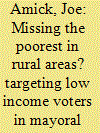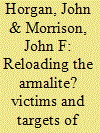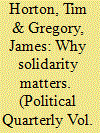|
|
|
Sort Order |
|
|
|
Items / Page
|
|
|
|
|
|
|
| Srl | Item |
| 1 |
ID:
071492


|
|
|
| 2 |
ID:
126558


|
|
|
|
|
| Publication |
2013.
|
| Summary/Abstract |
Recent audits have shown that anti-fuel poverty policies in the UK depend on loosely defined targeting and cannot accurately identify fuel poor households. New methods of targeting are necessary to improve fuel poverty policy. This paper uses Geographic Information System (GIS) techniques to evaluate the targeting of a home energy efficiency scheme small area level in Northern Ireland, based on the level of need. The concept of need is modelled using an area-based, multi-dimensional fuel poverty risk index. The characteristics and spatial distribution of household retrofits are explored. Policy activity and expenditure are compared with the level of need in an area. Results indicate that policy activity is only weakly associated with the level of need in an area, although policy appears to be well targeted in a few areas. Contrary to existing evidence, rural areas appear to be well served by policy, receiving above average numbers of retrofits and expenditure. There are typically two types of retrofit (major and minor). Most retrofits are minor and may not reduce fuel poverty. These results evidence the limitations of the current targeting system and suggest that there may be scope for improved policy implemented via a more proactive, area-based approach.
|
|
|
|
|
|
|
|
|
|
|
|
|
|
|
|
| 3 |
ID:
142642


|
|
|
|
|
| Summary/Abstract |
Jihadist violence is typically associated with being particularly indiscriminate. Often, as in variations of the ‘new terrorism’ thesis, this characteristic is proposed to correspond in some way to its other attributes such as its globalised, decentralised and ‘postmodern’ religious nature. Recent work appears to give more substance to such claims, by claiming to show a relationship between indiscriminate violence and decentralised group organisation. However, in this paper we show, based on an analysis of jihadist targeting in Western Europe and America from 2001 to 2013, that targeting choices by jihadists unconnected to organised militant groups have in fact been consistently more, rather than less discriminate in their targeting choices than their better-integrated peers. Drawing on this finding, as well as a broader reading of jihadist targeting discourses, we argue for a more complex understanding of the relationship between radicalisation, extremist ideology, decentralisation, and targeting choice.
|
|
|
|
|
|
|
|
|
|
|
|
|
|
|
|
| 4 |
ID:
160634


|
|
|
|
|
| Summary/Abstract |
This article utilizes an original household survey of two regency-level elections in Indonesia to explore campaign targeting. It uses a list experiment to show that direct survey questions about accepting transfers from campaigns elicit honest responses from respondents in Indonesia. Although the relationship between income and whether a respondent accepted transfers from political campaigns decreases over the entire distribution of income, it increases initially, producing a curvilinear relationship between income and accepting transfers from campaigns. This article argues that the poorest voters face barriers to being targeted by campaigns. However, these barriers recede as they become relatively richer, at which point a negative relationship is found due to diminishing marginal utility of accepting these transfers. Finally, in-kind transfers, as opposed to cash transfers, target low-income voters more effectively.
|
|
|
|
|
|
|
|
|
|
|
|
|
|
|
|
| 5 |
ID:
148917


|
|
|
|
|
| Summary/Abstract |
The centenary of the 1916 Rising marks a time of peaceful commemoration, across the island of Ireland. However, several violent dissident republican groups wish to seize it as an opportunity to re-organise in an attempt to bolster and legitimise their sustained paramilitary campaign. This study seeks to provide a greater understanding of how this paramilitary activity has manifested from 2007 to mid-2015. We do this by assessing target selection, through analysis of the Violent Dissident Republican (VDR) events database. The data suggest that civilian targets are the most regularly attacked. However, when exclusively analysing targets of detonated explosives, the data show that police, security personnel, and their infrastructure are more consistently targeted. The target selected can and does have an effect on attack method. These findings can both assist in protecting the potential targets of VDR attacks and contribute to the development of a strong nationalised, and localised, counter VDR narrative.
|
|
|
|
|
|
|
|
|
|
|
|
|
|
|
|
| 6 |
ID:
074711


|
|
|
| 7 |
ID:
190760


|
|
|
|
|
| Summary/Abstract |
How does targeting in armed conflict affect public opinion in conflict zones? Armed actors choose between targeting militaries and civilians, further choosing whether to target civilians discriminately or indiscriminately. Existing work suggests these choices have important implications for conflict dynamics, in part by influencing public opinion, yet the causal effects of these choices on individual attitudes have not been clearly established. We conduct a survey experiment in the Donbas region of Ukraine, an area that has witnessed years of protracted fighting. We find that reports of civilian targeting robustly reduce approval of both the government and separatist forces. However, we find that the effects of discriminate civilian targeting are not statistically distinguishable from those of indiscriminate civilian targeting. Finally, we find that our respondents generally preferred a restrained, rather than reciprocal, response from actors in this armed conflict. We explain the implications of our findings for theories of wartime violence.
|
|
|
|
|
|
|
|
|
|
|
|
|
|
|
|
| 8 |
ID:
141195


|
|
|
|
|
| Summary/Abstract |
Against a surprising level of agreement between Clausewitz, contemporary military doctrines and critical war studies on an ontology of war as fighting, we suggest that the study of contemporary warfare needs to focus more on war as processing. Through Jean Baudrillard we argue that at least some of what is referred to as ‘war’ is no longer characterised by encounters through fighting. We exemplify our argument by how the repetitive battle-rhythm of military targeting strives for perfect war. What remains is not war as an object in itself, but a reified ‘war’ that obscures the disappearance of that very object. The debate on war contributes to the reification of such a war, as an imperative telling us: ‘we have a concept, you must learn to think through it’.
|
|
|
|
|
|
|
|
|
|
|
|
|
|
|
|
| 9 |
ID:
073318


|
|
|
|
|
| Publication |
2006.
|
| Summary/Abstract |
As part of the structural adjustment programme the Government of India, in 1997, introduced the Targeted Public Distribution System (TPDS) with the objective of targeting the food subsidies to the poor and reducing fiscal deficit. While the universal Public Distribution System (PDS) had several limitations, the Targeted PDS has only worsened the problem of 'adequate access to food' for the poor. This article examines the limitations of income targeting based on the official poverty line under the TPDS. The article argues that the TPDS has worked counter-productively to the policy objective of reaching the poor. As per the National Sample Survey (1999-2000) and the National Family Health Survey (1998-9), a significant proportion of the poor and food insecure suffer from severe malnutrition and calorific deprivation. With a large section of the population falling out of the TPDS the article suggests policy alternatives to ensure better 'access to food' for the poor and vulnerable.
|
|
|
|
|
|
|
|
|
|
|
|
|
|
|
|
| 10 |
ID:
137850


|
|
|
|
|
| Summary/Abstract |
The prime component of China’s military strategy (A2/AD) is ‘offensive defence’ where surprise and pre-emption plays the key role. In this, ballistic missiles would play an important role, particularly in the opening hours of any conflict in the region. This concept is quite well laid out for a Taiwan scenario. It is to be noted that China has deployed more than 1,500 short range ballistic missiles (SRBMs) across the Taiwan Strait. The basic objective is, at the least, to soften enemy forces and, at the best, to break their war waging ability. The first objective of these asymmetric build up is to create a strong deterrent against any external military intervention so as to broaden the space for additional policy option to the leadership, particularly for assertive actions.
|
|
|
|
|
|
|
|
|
|
|
|
|
|
|
|
| 11 |
ID:
190994


|
|
|
|
|
| Summary/Abstract |
Few regions have been more plagued by terrorism than the Arab world. However, knowledge of the phenomenon’s nature is limited by a lack of attack plot data for most Arab countries. This article contributes to addressing this gap by presenting a dataset of jihadist incidents in Jordan from 1994 until the end of 2018. Based on recent progress in measuring terrorism, the dataset does not only include launched attacks but also foiled and failed attack plots to give a more accurate and comprehensive overview of the threat. It provides answers to fundamental descriptive questions such as how many plots there have been, which jihadist actors have been responsible, and what type of attacks they have attempted to carry out. This work matters because it reveals the main characteristics of the jihadist terrorist threat to the Kingdom. This enables future studies to provide more empirically based explanations of what causes jihadist terrorism in Jordan than previously possible.
|
|
|
|
|
|
|
|
|
|
|
|
|
|
|
|
| 12 |
ID:
156159


|
|
|
|
|
| Summary/Abstract |
To leverage the full range of observed variation in patterns of violence toward the development and testing of theories of political violence, scholars need adequate conceptual foundations: what should we mean by a pattern of violence on the part of an armed organization? Scholars often distinguish degrees or levels or types of violence across organizations and conflicts, but definitions and measures vary sharply. We argue that patterns of violence are not reducible in ways often assumed in the literature: lethal violence is not a good proxy for the overall pattern, and differences in patterns are not well captured in the binary “terror” versus “restraint.” To address these concerns, we provide a new conceptualization of political violence, defining an organization’s pattern of violence as the configuration of repertoire, targeting, frequency, and technique in which it regularly engages. This approach adds precision to the documentation and analysis of political violence, clarifies the evaluation of rival theories, and opens up new research questions. We demonstrate its utility through an analysis of violence against civilians in Colombia, drawing on an original database of massacres, judicial proceedings, and other sources, and show that the concept of “pattern” helps bring ideology and politics back into the analysis of organized violence.
|
|
|
|
|
|
|
|
|
|
|
|
|
|
|
|
| 13 |
ID:
172572


|
|
|
|
|
| Summary/Abstract |
Developments in artificial intelligence have ignited many debates on the use of autonomous weapons and ‘killer robots.’ However, before autonomous attack decisions can be explored, issues related to target selection need to be considered. Focusing the discussion on drones and artificial intelligence overshadows more fundamental issues. This paper therefore argues that the main ethical problem raised by autonomous drones do not come from the weapon system or technology itself. Instead, they stem from challenges of target identification. Thus, asking ‘what’s wrong with drones?’ is misleading as it focusses on the technology instead of the primary issue of target selection.
|
|
|
|
|
|
|
|
|
|
|
|
|
|
|
|
| 14 |
ID:
140870


|
|
|
|
|
| Summary/Abstract |
Terrorist groups are often relatively conservative in their choice of strategy, tactics, and targets, and it is worth asking what characteristics are associated with unconventional behavior. In this article we explore the question of why terrorist organizations move to one type of unconventional attack that has been a focus of concern of policymakers in recent years, namely attacks on maritime targets. Through an investigation of the organizational capacity and ideology of terrorist groups that committed maritime attacks between 1998 and 2005, we argue that this kind of violent behavior is driven by capability. Certain organizational characteristics of terrorist groups—territorial control, involvement in the drug trade, organizational size, and connections with other groups—provide groups with the capabilities that make maritime attacks both realistic and desirable. Terrorist groups' ideology—what they believe, and what their goals are—does not have the same impact, with the possible exception of groups affiliated with al-Qaeda. Our findings have implications for future research.
|
|
|
|
|
|
|
|
|
|
|
|
|
|
|
|
| 15 |
ID:
096265


|
|
|
|
|
| Publication |
2010.
|
| Summary/Abstract |
Reporting on our recent book, The Solidarity Society, this article explores the way in which the design of welfare programmes interacts with and shapes the underlying quality of social relations between members of society-and, through this, public attitudes to welfare. Given that sustaining generous welfare over long timescales requires the support of electorates, this 'relational' dimension of welfare policy is crucial for the long-term strategy of tackling poverty and inequality. The article looks in particular at the 'welfare dilemmas' that can arise from tensions between targeting and universalism and between need and entitlement, where the distributional and relational elements of welfare policy work against one another. We conclude that entrenching a generous welfare settlement will require strong elements of both universalism and reciprocity in the design of welfare.
|
|
|
|
|
|
|
|
|
|
|
|
|
|
|
|
|
|
|
|
|